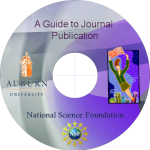

Publishing
Once your paper has been accepted, your duties as the author are not over.
- You will be actively involved in checking page proofs and eliminating errors. These are commonly done via the internet and pdf files. The editor will make comments or ask questions on anything that is unclear or does not look right. For example, a reference in the reference list that is not cited in the text or an incomplete reference. The editor may have also made small wording changes for readability or grammar. You must respond to page proofs promptly! If you neglect the page proofs when you are nearing the publication point, your article will go to print as is. After all the time and effort invested in getting the article accepted, you want it to be flawless in print, so be meticulous and prompt when acting on your page proofs. Especially check equations and other special formatting which may not have translated exactly from your file to the printer's.
- After your paper has been accepted you will be requested to sign a copyright assignment stating that your article is not in publication in another place. After signing the copyright assignment, you are giving the publisher permission to print the article within a specific time frame. You might sign for other authors as instructed by the copyright form of the journal.
- Be sure to include any acknowledgements in your paper, referencing the appropriate source by name.
- Some journals require a brief biographical sketch (generally less than 200 words) to accompany your accepted paper. Be sure to accurately describe yourself and credentials, as other researchers in the field will be reading the paper. Some journals request a photo - this should be a professional looking "headshot" in a digital, preferably black and white, format.
- Some journals have page charges. These are one time fees that someone must pay to publish the paper. They may apply to all articles, to those which exceed a "free" page length limit or those which require color reproduction. Some page charges are optional and if you are an academic without funds, you can decline to pay them. Usually page charges are quoted by length, that is, number of published pages. Some institutions and some research contracts will pay page charges while others will not.
- Usually the journal provides some sort of publishing bonus to the author - a free copy of the journal issue in which your paper appears, a number of reprints of your paper at no additional charge or the pdf file with permission to reproduce it. These are only sent to the corresponding author and the corresponding author is responsible for relaying to the other authors. Most journals charge for printed reprints, also called offprints, or in the case of journals who provide authors with free reprints, you will be charged for those in excess of the free number or those that are specially packaged. When your paper is accepted, you will get information from the journal concerning their particular policies in this regard.
- It is possible that your paper is published with an error in it. If the error is important to understanding the paper or reproducing the results, you should write a brief "Erratum" and send it to the journal. This would be published in a future issue referencing your original paper and correcting the significant error. Occasionally such errors are found by another reader, or possibly a reader might dispute an important point of your paper. In this case, the journal might publish a brief "Note" from this reader or readers regarding your paper and would usually offer you the opportunity to counter this Note with your own Note, also published. Please be aware that the instances discussed in this paragraph are rare and it is likely that you will not be involved with such post publishing notes during your career.
